In our last round-up of the year, we’ve selected twelve titles from eight countries, with tales of grand adventure and prose of intimate beauty, novels tracing orature or the piecing together of history, rediscovered poetry and letters from literary titans, stories tinged with horror or fantasy. . . All to send the year off the best way we know how: in the company of our world’s brilliant writers.

What Remains: The Collected Poems of Hannah Arendt, translated from the German and edited by Samantha Rose Hill with Genese Grill, Liveright, 2024
Review by Liliana Torpey
In What Remains: The Collected Poems of Hannah Arendt, we are invited into the private, poetic life of the author behind the seminal political texts The Origins of Totalitarianism and Eichmann in Jerusalem. The door is not opened by Arendt herself—who never published her poems and seemingly never intended to—but by the volume’s translators, Samantha Rose Hill and Genese Grill, who dove deep into the archives to collect these poems. Reading them feels at once like a gift and a faux-pas, knowing that we are trespassing upon the intimate thoughts and gestures of one of the twentieth century’s great political thinkers.
The entirety of Arendt’s poetic corpus appears in this book. For a lifetime it doesn’t seem like many—seventy-eight in total—but the book’s thorough introduction, translator’s note, and footnotes reveal just how carefully Arendt stewarded these poems over the years. Hill and Grill detail the way that Arendt hand wrote each piece in a notebook or letter, then continued to edit by hand before finally typing up the poems and arranging them chronologically, by season. Packing many of them alongside her essential documents when leaving Germany, her poems “remained among her most prized possessions.”
This care is evident in the poems themselves, which often fall on the shorter and sparser side. It’s clear that Arendt had considered and reconsidered each individual word, trying to communicate what she felt and sensed. In many cases, that world appears to be a rather bleak one: “The sky is in flames, / Heaven is on fire / Above us all, / Who don’t know the way.” While her political writings directly address the mechanisms of violence and authoritarianism, her poems often reveal an unsettling and probing uncertainty.
Alongside—and perhaps stemming from—this uncertainty flows a desire and sensuality that animates Arendt’s curiosity and nostalgia: “Heart warmth / Heart grace / Inhaling deep emotional-being / Sighing softly / Like cloud mist / Audibly trembling touched-being.” Her precision and tenderness are disarming, though not totally distinct from the Arendt that readers may already know. Marked by ambivalence and vulnerability in the face of life’s great mysteries, these poems don’t simply reveal all that we hope to know about Arendt’s internal landscape; instead, they deepen a sense of wonder that hovers, always, just beyond our reach.
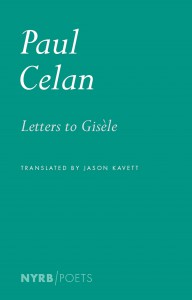
Letters to Gisèle by Paul Celan, translated from the German by Jason Kavett, New York Review Books, 2024
Review by Len Sander
“You were everything for me, often that collapsed, but you remain everything for me,” writes Gisèle Celan-Léstrange to Paul Celan during the summer of 1966. She is on holiday, seeking respite. By then, the couple had been married for fourteen years, a time marked by both closeness and disintegration. In 1967, Gisèle will part ways with her husband, though their marriage will last until his death in 1970. Despite their separation, they will continue exchanging letters until the end.
In that same letter one finds the lines: “A pebble, a blade of grass, the line of a hill, witnesses of the perpetual drama of nature, are realities for me, which can help me. Not to understand but perhaps to know.” A note, a quickly scribbled poem, an observation of their son Eric—scraps from the perpetual drama of human nature and relationship, become realities for us, their readers, which can help us. Not to understand, but perhaps to know. . .
. . . of a love shared by two artistic minds: a poetic genius and an illustrator, a father and a mother, lovers, tireless letter writers. In Letters to Gisèle, we glimpse not only their emotional connection but also the pragmatic dimension of their relationship—the careful planning necessary to stay afloat. “Here, furthermore, for Moret, the schedule (communicated by Elmar and which I am maintaining): Tuesday: 9:30–10:30 beginners; 14:30–16:30 agrégation students; Friday: 14:30–16:30 agrégation students; 16:00–17:00 beginners; 17:00–18:00 advanced.” The collection also includes tender letters written by Paul Celan to his son, Eric, detailing their everyday communication: “Work well, amuse yourself well, write to me.”
Letters to Gisèle is a book to hold close while reading Celan’s poetry, or to examine the anatomy of a relationship over time. On May 1, 1969, Gisèle writes to Paul: “Accept that in the midst of all these difficulties there is all the same a place for little miracles, try to be able to recognize them. I assure you that they exist despite everything.” Less than a year later, Paul would take his own life.
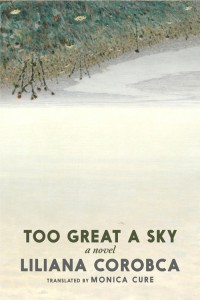
Too Great a Sky by Liliana Corobca, translated from the Romanian by Monica Cure, Seven Stories Press, 2024
Review by Regan Mies
With Too Great a Sky, Moldovan author Liliana Corobca telescopes into one girl’s experience of deportation. In a fictional narrative that evokes oral history, the novel’s three parts—a community’s deadly and weeks-long journey by train, years of impoverished exile on the Siberian steppe, and a post-war aftermath—mingle with short beats of a frame narrative: the main character, Ana Blajinschi, is recounting her story to her great-granddaughter, visiting in the days preceding a proposed move to a nursing home.
Based on the Soviet occupation of Bucovina, Romania in 1941 (now Ukrainian Bukovyna), Too Great a Sky continues Corobca’s fascination with how the past can be communicated into the present. Her first novel to be translated into English also operates in a frame narrative, in which a woman wanting to donate a 1974 censor’s notebook exchanges emails with a fictional Corobca, who is employed at a museum. With Too Great a Sky, a move toward a spoken mode of storytelling makes perfect sense; while conducting research for her past academic writings, Corobca worked with over eighty testimonies of Bucovinian survivors who experienced deportation during World War II, all of which no doubt contributed Too Great a Sky’s uniquely human polyphonic texture.
Elements of orature are integral to Ana’s account of her past, which moves fluidly into and out of fable and aphorism, prayer and hymn, poetry, and folk song—rendered by Cure into English with sharp attention to “folksy tone,” rhythm, and rhyme. As a result, Too Great a Sky is a many-layered epic, near-Odyssean in its scope, cast, and shifting landscapes, and it never shies from the graphic hardships faced by deportees: starvation, overwork, sexual assault, religious and cultural oppression, the violence of the natural world, extreme poverty. The list of horrors can feel unending, yet Ana’s story confronts and survives these realities through stunning acts of strength, hope, humor, and awe.
Considering the specific, intimate detail with which Ana conveys her individual experiences, it’s the story’s movement through these traditional oral forms that enables its magnificent expansion; Too Great a Sky carries not only the experiences of one young woman, but the shared culture and collective history of a region—and a people—forced to face, then overcome, irreparable tragedy and transformation.
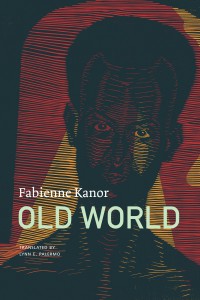
Old World by Fabienne Kanor, translated from the French by Lynn E. Palermo, Seagull Books, 2024
Review by Len Sander
New Orleans is not Orléans. The former is in the United States and the latter is in France, not far from its capital, Paris. But the two cities share similarities: both are mid-sized and situated near significant bodies of water—the Mississippi and the Loire, respectively. They also have a historical connection through colonialism, dating back to when Louisiana was a French colony.
In Old World, French writer and Orléans native Fabienne Kanor sends her protagonist Nathan on a present-day journey to what was once the New World: New Orleans. Nathan, born in Cameroon (yet another place once colonized by France) is embarking on a mission of self-discovery, searching for traces of his great-grandfather Etienne John Wayne Marie-Pierre, who had come to Louisiana in pursuit of a better life. Toward the end of his rather resultless search, Nathan reveals his motivation: “I imagined that we resembled each other some, he and I, and that we were equally monstrous. Wandering disfigures a man.” Does it, though?
Through his wanderings, Nathan attempts to reconstruct his identity as a Black man, an African turned European, a lover, a son. These dimensions come into conflict with his perception of the mesmerizing yet troubled city of New Orleans, where he encounters numerous Black southerners, learns their stories, and witnesses the societal frictions in which they are entangled, along with their ways of grappling with the past.
However, the protagonist’s perspective is compelling only if one follows his identitarian mode of thinking. Even the familiar contradictions of modern American society unsettle him, leading to rather ordinary observations: “Her hands gripped the neck of the bottle of Chandon on which someone had written The party starts here. It was so cynical. In this luxury vehicle, which a servile chauffeur, up front behind his window, was guiding over the bumpy road, nothing signaled a party or the beginning of anything.”
As a whole, Old World struggles to bring its elements into meaningful tension. At times, it feels like a conceptual exercise, a dry run. This may be due to the pale style that pervades much of the novel. Even so, it achieves interesting moments, evoking the feel of a reportage-style road trip—a kaleidoscope of biographies and snapshots of the American South.
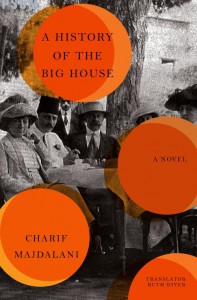
A History of the Big House by Charif Majdalani, translated from the French by Ruth Diver, Other Press, 2024
Review by Regan Mies
In the opening pages of Charif Majdalani’s A History of the Big House, its narrator declares his ambition: “I held all the pieces in play at last, and I could now re-create the history of the entire family. . .” The pieces he refers to include objects—land registration documents, his great-grandfather’s signet ring and ebony cane, a box of correspondence—but the most important components are stories: memories sourced from elderly relatives, anecdotes long repeated at family gatherings, and narratives transformed into legend from one generation to the next. Beginning the Nassar family chronicle with the exile of his grandfather Wakim at age twenty, he immediately encounters an ambiguity: Why were Wakim and his brother thrown out of Marsad and forced to settle in nearby Ayn Chir? The inciting incident had been “lost in the hazy limbo of rumor and hearsay, before it was reconstituted in the memory of his descendants in the form of implausible legends.” The narrator can only hypothesize: could the exile have been a result of a spat after a game of dominoes? A deadly confrontation? Something to do with a woman?
Along with the necessary evidence-driven detective work, the narrator realizes that subjective decisions are inevitable when constructing history—which is always more fluid than one anticipates. He recounts Wakim’s cultivation of a flourishing orange plantation, his construction of a magnificent estate called the titular Big House, and even—possibly—his invention of the clementine. When arriving at the time of his grandfather’s search for a wife, the narrative hits another roadblock. Two versions of this marriage story exist in the family lore; the narrator begins telling the first, but soon concedes that he’s been “seduced by its drama,” going on to dive into the second, “more pragmatic,” version.
Collisions between heroics and practicality are staples of Majdalani’s novel. Theatrics—galloping gangs on horseback, secret baptisms, ambushes, abductions, grand betrayals—mingle masterfully with a century of Lebanon’s history, events that make room for the manifestation of genuine heroism: the Big House takes in refugees after Beirut is bombed during the Great War, Wakim harbors conscription dodgers after the Ottoman Empire lifts military protections, and eventually, his young family survives the tumult of banishment to Anatolia.
Amid patterns of alternating certainty and speculation, the narrator reaches “truth” through a determined, trial-and-error type of storytelling. In Ruth Diver’s translation, the earnestness, jubilation, and confidence with which Majdalani’s narrator renders the Nassar clan’s history shows that all great stories might be most authentic at the intersection of strict reality and imaginative reconstruction. “All of those would do,” he says after navigating potential versions of an event. “All of them could be the start of an infinite multiplication, and what I am going to choose, arbitrarily, is another version entirely. Here goes.”
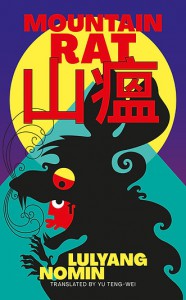
Mountain Rat by Lulyang Nomin, translated from the Chinese by Yu Teng-wei, Strangers Press, 2024
Review by Liliana Torpey
Mountain Rat is the third chapbook in Strangers Press’s ká-sióng series, a collection of work from Taiwanese writers and translators, with ká-sióng referring to “‘false thinking’ / imagination / hypothesis.” Colorfully designed and fully realized at a brief twenty-four pages, Mountain Rat stands on its own as an ominous experiment in imagination and an exploration of the false thinking that can overtake us.
Nomin’s protagonist—only identified by the family name of Watan—is a logger who has, for the last several years, “been toiling at cutting down high-value burls on Taman Mountain to sell to timber wholesalers.” But before we learn anything about him, we see him being bit on the Achilles tendon by a mountain rat. The story then unfolds as he quarantines in his grandfather’s bamboo hut, expecting the worst—which arrives quickly as the logger’s body is transformed into that of a giant rat, and his mind is possessed by the voice of Busus, the Rat King.
Satisfyingly sinister, the story hints toward a cultural phenomenon rather than a strictly internal battle. The protagonist, who speaks the indigenous Atayal language, identifies the seemingly venomous rodent as a “mountain rat”—the local term for illegal loggers, who are described as being primarily migrant workers. While the protagonist walks down the mountain with one of these same workers, he asks the worker, Pattiye, if he ever thinks about going home, to which Pattiye replies: “When you loggers don’t need me carry timber on my back no more… Then, I surrender to police and take a free plane ride home.” While Pattiye is in good spirits, his position in the clandestine supply chain of illegal timber is clear—even more so when he falls over the edge of the mountain under the weight of the wood on his back, succumbing to the risks of the trade.
However, as Busus overtakes Watan’s body and consciousness, he asserts his hold over the dominion of local loggers as well: “All the young people of the Maling Village know me: With just a bit of meth and a piece of burl, I can be reborn.” Playing with the boundaries of self and other through the image of the monstrous, Nomin effectively creates a window into an alternate world where labor, nature, and our lesser instincts merge, taking on lives of their own.

A Horse at the Door by Wadih Saadeh, selected and translated from the Arabic by Robin Moger with an afterward by Youssef Rakha, Tenement Press, 2024
Review by Liliana Torpey
Through the poems of A Horse at the Door, taken from works published between 1985 and 2012, the Lebanese-Australian poet Wadih Saadeh allows himself to be known. Recounting his memories, his fears, and his attempts to assuage them, Saadeh treats the reader as a welcome companion with whom one can exchange dark jokes over arak and cigarettes. He addresses connection and its absence, continually applying permutations of friendship to both familiar and unexpected subjects, from the possibility of befriending passers-by to the clouds and their shadows, limbs and feet, and ourselves. As Youssef Rakha writes in the collection’s afterward, “The intensity and the intimacy is such that it feels like Saadeh is telling your life story, not his…”
Covering the many phases of Saadeh’s life, these poems return consistently to the liminal act of departure: his father’s departure in a tragic and painful death when Saadeh was fourteen; his own departure from various European cities as a young man yearning for arrival; the departure of contemporaries and families migrating away from war; and the departure of limbs from bodies on the battlefield. Saadeh does not only witness departure, but also what it leaves behind: “On the surface of the lake is a leaf. It was an eye. On the bank is a branch that was a rib. / I am trying to gather up the leaves and the branches. / I am trying to gather together someone whom I loved.” He considers how one may live with the traces of the departed—and perhaps what it feels like to be such a trace, left behind in the wake of loss and flight.
This departure, too, becomes a friend, something familiar and beautiful. It becomes a kindness—permission to leave behind the horrors of being present in the world, with each other. “Is this why it is more important to befriend departing / than settling? / Is this why our lives must be no more than a rehearsal of / the beauty of departure?” Stunningly wrought in English by Robin Moger, Saadeh’s poems are not satisfied with certainty, nor do they ask rhetorical questions. They ask for your dreams, your losses, your questions—as a friend might do.
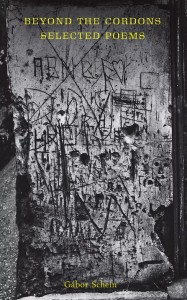
Beyond the Cordons by Gábor Schein, translated from the Hungarian by Ottilie Mulzet and Erika Mihálycsa, Contra Mundum Press, 2024
Review by Liliana Torpey
The poems in Beyond the Cordons, written by Gábor Schein and translated by Ottilie Mulzet and Erika Mihálycsa, are printed in landscape format across the page. You have to turn the book sideways to read them, flipping the pages from below rather than right to left—a visual distinction that grants the poems more expanse to examine the urban, social, and interior landscapes they evoke.
The city looms large over Schein’s verses, asserting even its loneliest and least coherent states. It establishes its centrality from the collection’s first poem, which shares the collection’s title: “If the burnt-out car wrecks / and ripped-up cobblestones had been removed, still, the missing pavement / let no one forget: the city center was a zone of uncertainty.” A sense of distrust marks the poet’s relationship to the city (which, though unnamed, is presumably Budapest, where the poet lives); it appears as an inquisitor, an apparition, a trap, a site of both amnesia and troubling memory. “Do you know your shame, / my ghost homeland? Do you know why everything remains / in its place of ruin?”
The social landscape mimics the urban one, mapping experiences of collective alienation (“Why do we run away from each other?”) and personal loss (“for my dead: / Magda, Péter, Szilárd, my father, / I don’t understand why they’re not sitting / with me now here in the kitchen”). Schein dedicates poems to the memory of fellow writers, Gizella Hervay and Osip Mandelstam, as well as a loved one who has succumbed to cancer. While human connection remains an access point into tenderness, it is not a source of salvation, instead mirroring the uncertainty of chaos of the city: “we will have to give account / of what ruptured in us, while embracing.”
Such ruptures trace the gutters and tram lines of the city streets straight into the internal world. While interfacing with the harsh external landscape, Schein’s poems are decidedly introspective, weighing the significance of guilt, grief, and despair. The narrow pages overflow with conflicting and agitated feelings, perhaps because “a single person is too narrow a space for so many wants and desires.” Beyond the Cordons bursts with them, even as they are met, time and again, with disappointment.
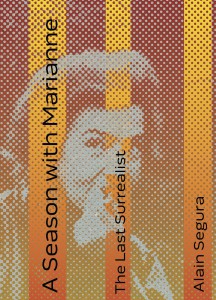
A Season with Marianne: The Last Surrealist by Alain Segura, translated from the French by Anna O’Meara and Sarah Lynne Roberts, Common Notions Press, 2024
Review by Regan Mies
“Her long, dark silhouette against a red bench looked like the recurring vision of a ghost. . . I soon came to understand that around her, nothing could be assumed.” To Alain Segura, Marianne Ivsic was as much a myth as she was an artist, advisor, and friend. Both elusive and infamous amid the student and anarchist circles of Paris around the unrest of May 1968, Marianne was a painter and occasional poet with a mysterious past as a Yugoslavian militant. Meanwhile, Alain Segura was the son of a Spanish anarchist who had settled in France, and a member of the Anarchist International during his young adulthood in Paris. There, he grew close with members of social revolutionary groups such as the Enragés and the Situationist International, through which he first met Marianne in 1967.
While they knew each other, Segura was in his late teens and early twenties; Marianne, elegant in her fifties. She was an “alchemist,” according to Alain: “The attraction of Marianne often made us lose our sense of reality. In the athanor of her workshop, everything was vividly colored, bathed in a magic glow, under the smoky cloud of our cigarettes.” Though beautiful, Marianne’s allure wasn’t romantic or sexual; for Segura, it was the “confusion and amazement” provoked by her brilliance that pulled so many into her orbit. She had no qualms about shutting down ideas and arguments, and she held her beliefs firmly: “Destroy power without seizing it”; “Love and do what you want”; “a revolution must be conducted by happy people,” the only ones who “wouldn’t give into the vertigo of power.” She was generous, opaque, all-encompassing—a center of gravity both benevolent and volatile.
In A Season with Marianne, translated by Anne O’Meara and Sarah Lynne Roberts, Segura traces his path through Paris—both past and present—with a series of brief recollections, portraits, and pastiches, accompanied by photos sourced from old friends or the Historical Dictionary of the Streets of Paris. On his pilgrimage, Segura leans into the mystic and unknowable; he breathes the “ancient air” of old haunts and imagines hands reaching out from dusty volumes on bookstore shelves. When he travels to Marianne’s old address after her death, he wonders: “What was there for my camera to capture? The spirit of the place had been distinguished.” Can a spirit be sufficiently captured in writing, then? Marianne was private in her life, and though Segura doesn’t purport to uncover the secrets of her identity in her death, his memoir succeeds in preserving his memory of a lively and intellectual avant-garde community, while paying tribute to Marianne Ivsic’s singular and impassioned spirit.
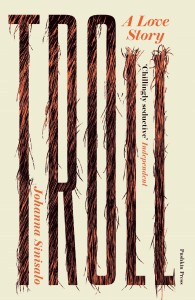
Troll: A Love Story by Johanna Sinisalo, translated from the Finnish by Herbert Lomas, Pushkin Press, 2024
Review by Regan Mies
If Troll is “a love story,” who is in love with whom? Angel, a young photographer in Finland, is returning to his apartment late one night when he catches a gaggle of teenage delinquents shoving around something small behind a bank of trash bins. The creature is sleek and slender, covered in thick black hair. Angel determines it’s young—just a cub—and the “most beautiful thing” he’s ever seen. By saving it, he brings home a troll.
The original UK and US covers of Johanna Sinisalo’s Finnish novel, translated by Herbert Lomas and published in 2004, lean into horror: gritty photographs of eerie forests or indistinguishable creatures, just out of frame. But the charming, typeface-based cover of Pushkin Press’s 2024 UK reissue evokes whimsy. To me, the tone of Sinisalo’s strange contemporary fable lands somewhere amusing, unsettling, and in-between the genres suggested by each cover.
Angel isn’t shocked that the creature he has rescued is a troll, nor are any of the novel’s characters; like the American Sasquatch or Tibetan Yeti, an article on the website “netzoo.fi” informs Angel that trolls are representatives of the “humanity-shunning Felipithecidae family” (resembling apes and humans, though genealogically unrelated to hominids) and that concrete evidence of trolls was originally obtained by the Tsar Alexander University of Helsinki in 1907. Scientific articles, online encyclopedia passages, and newspaper clips are just some of the secondary sources that appear throughout the text to validate the reality of trolls in Sinisalo’s version of Finland, and relegates the question of their existence to the novel’s sidelines. What takes up space center stage, instead, is Angel’s relationship with the troll being nursed back to health in his apartment.
Sinisalo introduces a cast of characters through revolving, first-person perspectives, each of whom, in their own way, is in love with Angel: two ex-boyfriends—one a pretentious veterinarian, one an ad-man in fashion; the unhappily married foreign woman in the apartment downstairs; and a current boyfriend who meets a too-early demise. But it’s the bond between Angel and his troll that thrums with increasing intensity and dependency. A strange understanding grows between man and animal, which transforms into kinship and, eventually, the possibility of something more. Funny, seductive, and unarguably original, Troll is about the thrill and reverence of instigating a deeper connection with wildness, with the tradition and ancient folklore of one’s culture, or simply with the unknown.
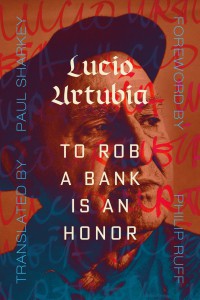
To Rob a Bank Is an Honor by Lucio Urtubia, translated from the Spanish by Paul Sharkey with a foreword by Philip Ruff, AK Press, 2024
Review by Liliana Torpey
“During that time, I was able to ‘liberate’ lots and lots of money from several banks, on my own or with company, not that it matters, and I don’t like talking about it,” writes the late Basque anarchist Lucio Urtubia, somewhat paradoxically, in his autobiography To Rob a Bank Is an Honor. Translated by Paul Sharkey in personable yet straight-shooting prose, Urtubia tells his life story in a series of lively and life-affirming Galeano-style vignettes, with subtitles ranging from “My grandparents,” to “Military contraband,” to “The Argentine World Cup (1978).” This latter tale recounts how a group of antifascists had attempted to kidnap French soccer player Michel Platini, “in order to force the cancellation of the World Cup and thereby salvage the world’s honor rather than allowing it to disgrace itself by going to play in Argentina,” which at the time was ruled by a violent military dictatorship.
This anecdote represents just one of the various abductions and “expropriations” that Urtubia participated in and supported throughout his lifetime. While not free of mistakes, these activities were always carried out in support of liberation movements across the world, rather than for personal gain: “Where there is a will, there is always a way to help others and for solidarity work.” Despite straightforward retellings of his highly publicized extrajudicial activities—most notably the “liberation” of millions of dollars from Citibank via forged travelers’ checks—Urtubia does not revel in his status as a bandit or a real-life Robin Hood. Above all, he sees himself as a revolutionary who has embraced the values of self-management, honesty, and accountability through work. “Any time the police came looking for me,” he states, “they found me working.”
Rather than a glamorous memoir of individual heroism, Urtubia recalls a life rich in struggle, friendship, and proud dissent against all authority figures and institutions—while never downplaying the potential consequences of rebellion. Despite being, in his own words, “answerable to no one,” To Rob a Bank Is an Honor advocates against alienation, instead championing the diligence, dedication, and love for life that is necessary to build solidarity and a better world: “. . . it is a privilege to be drained to the last drop as we strive to make life richer for ourselves and for our children and grandchildren.” In the wake of Urtubia’s death in 2020, this memoir reads as a triumphant conclusion to a lifelong pursuit of justice. May we all be so privileged, when looking back on our lives, to know—or at least believe—that we had done everything we could for the sake of freedom.
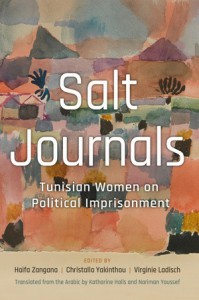
Salt Journals: Tunisian Women on Political Imprisonment; edited by Haifa Zangana, Christalla Yakinthou, and Virginie Ladisch; translated from the Arabic by Katharine Halls and Nariman Youssef; Syracuse University Press, 2024
Review by Len Sander
Tunisia has endured various authoritarian regimes over the recent decades: first under Habib Bourguiba, then under Zine El Abidine Ben Ali, and now under the increasingly autocratic leadership of Kais Saied. But about fifteen years ago, a glimmer of hope had appeared with the fall of long-term dictator Ben Ali. With a relatively robust civil society and secular outlook, Tunisia appeared to be on a path toward democratic freedom and economic prosperity. However, this hope was short-lived. With Kais Saied as president, Tunisia finds itself once again slipping back into authoritarianism.
Alongside this turmoil, there has developed a rich Tunisian literary tradition of political prisoners recounting their suffering. However, as the editors of Salt Journals have observed, the significant repression of women—whether exerted directly through imprisonment or indirectly by having relatives or partners imprisoned—has often gone unshared. This silence speaks volumes about the state of Tunisian society, including its oppositional circles and the limited space it affords to women. Now, Haifa Zangana, Christalla Yakinthou and Virginie Ladisch have taken on the commendable task of collecting voices of female Tunisian political prisoners, gathering their stories through a series of workshops.
Among its noteworthy contributions is “On the Slopes of Borj Erroumi” by Malika Missaoui, an emotive piece of micro non-fiction about a mother and son, on their way to visit their husband/ father in prison. It is a fantasy of shelter and warmth in a situation of utter discomfort. There’s also “Grandfather” by Mylène Hammi, a tender mini memoir dedicated to the author’s dead grandfather; the piece is at once a prism of memories both sensual and political, and a way of mourning. Other contributions are permeated by political phraseology, giving them an agitprop feel: “That’s how our men are: sons of the untiring women of our villages, they are nursed on integrity and dignity,” as Soulefa Mabrouk writes in “Bourguiba—God of Tunisia?”. “When Fadhel was killed, his blood, like the blood of his comrades before him, nourished the homeland’s soil,” writes Hana Abdouli in “The Bread Intifada.”
This friction is perhaps due to the nature of such an endeavour—simultaneously a political statement, a historical record, and a collection of literary works. While a stronger emphasis on the literary and sensory qualities of the pieces could have done the collection good, it remains a compelling portrayal of the struggles and perspectives of women in contemporary Tunisian society, living under the suffocating spell of authoritarianism.
Regan Mies lives in New York. Her reviews, interviews, and translations have appeared in the Los Angeles Review of Books, Cleveland Review of Books, the Chicago Review of Books, New Books in German, No Man’s Land, and elsewhere.
Len Sander is a writer whose literary work has appeared in German and English in journals such as Synchron, Soft Union and The End. He holds a BA in literary writing from the German Institute for Literature Leipzig and a MSc in theoretical psychoanalytic studies from University College London. In 2023, he cofounded the literary magazine Bindung. He is currently working as a staff writer for a Berlin-based daily newspaper.
Liliana Torpey is a writer from Oakland, CA. Her work has appeared in The Rumpus, NACLA, and Euronews Culture. She is currently pursuing an MFA in Creative Writing at San Francisco State University.
*****
Read more on the Asymptote blog:

